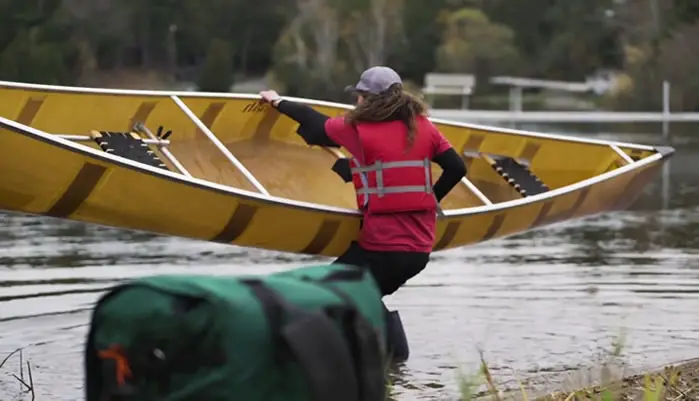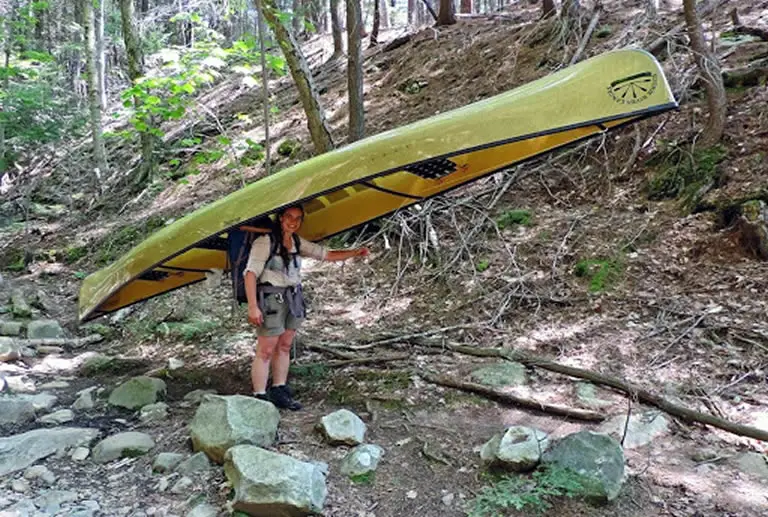Canoe trips are exciting. Well, that is until you have to carry your canoe over land to go from one body of water to another – something known as portage.
Portage can be a pain in the neck (both figuratively and literally).
Contents
What portage is & why it sometimes sucks!
When on long duration paddling trips, or when boat camping, you are not always on the water.

It doesn’t matter what anyone says, it doesn’t matter who they are or what experience they have, if someone tells you that portage is fun they are, in the words of the naturalists and star of the documentary film WaterWalker, “… either a liar or crazy“.
Portage sucks!
Lugging a heavy boat over your head with your shoulders taking most of the weight is no fun at all.
Portage is as easy or as hard as your canoe makes it.
Portage gets even worse when you have to avoid slipping on slimy rocks or falling down steep inclines.
Tramping through thick mud and having to tolerate bug-filled hollows can make you wish you had chosen to paddle down a nice easy local creek instead. Or worse, it can leave you wanting be back at home watching TV.
And, let’s not even mention how soul destroying taking a wrong turn can be.
In addition to all the woes that can befall a portage canoer, it can be a test of your temperament when you soon discover that at least one of your fellow canoeists thinks their share of the load should be much lighter than yours.
The advantages of portage
However, portage has its advantages and once you get the canoe back in the water all the pain is forgotten.
But how can you mitigate that pain, or at least reduce it substantially, so that portage becomes more part of the canoeing experience and less of a pain in the a**?
Obviously the most important consideration when it comes to portage is the weight of your boat.
Reducing the weight you place on your shoulders when you portage will go a long way to making portage less of a chore.
Although the size of your canoe will obviously have an effect on its weight this is less of a contributing factor than the material the canoe is made from.
The best canoes for portage
So what is the best canoe for portage to help reduce that pain?
The best canoe for portage will be the lightest boat.
Although length is also a consideration, weight is the most important factor.
- Aluminum canoes tend to be very heavy.
- Polyethylene/plastic canoes are even heavier.
- Fiberglass canoes are a lighter option than the previous two.
- By far the best canoe for portage will be made from Kevlar as it is 20% lighter than a similarly sized fiberglass canoe.
Let’s take a look at the most common materials used for manufacturing modern canoes and see how well they are suited to portage.
How good polyethylene canoes are for portage
Polyethylene is a type of hard plastic used to make kayaks.
Although it is made from plastic a polyethylene canoe is not as lightweight as you may think.
In fact these type of canoes are among the heaviest and are therefore not a great choice for portage.
Standard sized plastic canoes weigh on average about 80 lbs.
Perhaps aluminum is a better choice!
Aluminum canoes are also heavy.
Although hard-wearing and requiring very little maintenance, aluminum canoes take their toll on the canoeist when carried over long distances or rough terrain.
Standard sized aluminum canoes weight on average about 70 lbs.
Fiberglass is lighter and better for portage
A fiberglass canoe is lighter than both plastic and aluminum. But that doesn’t mean it’s light.
A standard sized fiberglass canoe will weight between 60lbs – 65lbs making it only slighter lighter than an aluminum alternative.
Wood can be too heavy for solo portage
Wooden canoes can be very expensive and very heavy.
A canoe made from a kit can look absolutely stunning.
Canoes made from a hard wearing high quality wood really have no equal in the looks department but unfortunately they are heavy and many of them are really not suited to portage at all.
A home built canoe made from lightweight marine plywood and epoxy is a different matter though.
Marine plywood, if first treated and then maintained correctly, is durable and can look stunning when varnished.
However, its biggest advantage is its weight.
A marine plywood canoe is incredibly light and a great choice for portage.
A small solo wooden canoe will weight about 50 lb.
A marine plywood home build canoe will be considerably lighter with its overall weight dependent on the boat plan you use to build it.
Kevlar – the best canoe for portage by a long way
A canoe made form Kevlar will be, by far, the best choice for portage because it is the lightest type of canoe you can get.

Just one or two trips where you have to portage your canoe from one navigable waterway to another will either make you glad you have a Kevlar canoe or wish you had one!
Of course Kevlar is not the only composite material available but it is the most common and the most popular among canoe manufacturers.
Why Kevlar canoes are perfect for portage
Below are some of the best Kevlar canoes for portage.
Kevlar canoes are not only much lighter than the alternatives but they are much stronger as well.
In fact a Kevlar canoe will be 25% lighter than a fiberglass equivalent and a lot stronger.
The lightweight nature of these boats obviously makes a big difference on long portages, but you’ll pay for it!
Kevlar canoes are among the costliest canoes on the market because they are time-consuming to make and use multiple construction materials.
Kevlar canoes are manufactured in a similar way to fiberglass canoes where layers of fabric (in this case Kevlar instead of fiberglass) are interwoven and bonded with special resin.
Being lighter, Kevlar canoes are not only easier to portage but are easier to paddle than canoes made form other materials.
As you can see the only drawback to buying a Kevlar canoe is the price.
However, it will only take one long distance canoeing trip with portage required for you to wish you’d spent that extra cash on one!
If the cost of these canoes are a little too rich for you, and you are the handy type, then you should consider building your own Kevlar canoe instead.
The top 3 Kevlar canoes for portage
Canoeists demonstrating how light a Kevlar canoe is (video)
You can see how easy it is to carry a Kevlar Northstar canoe in the video below.

